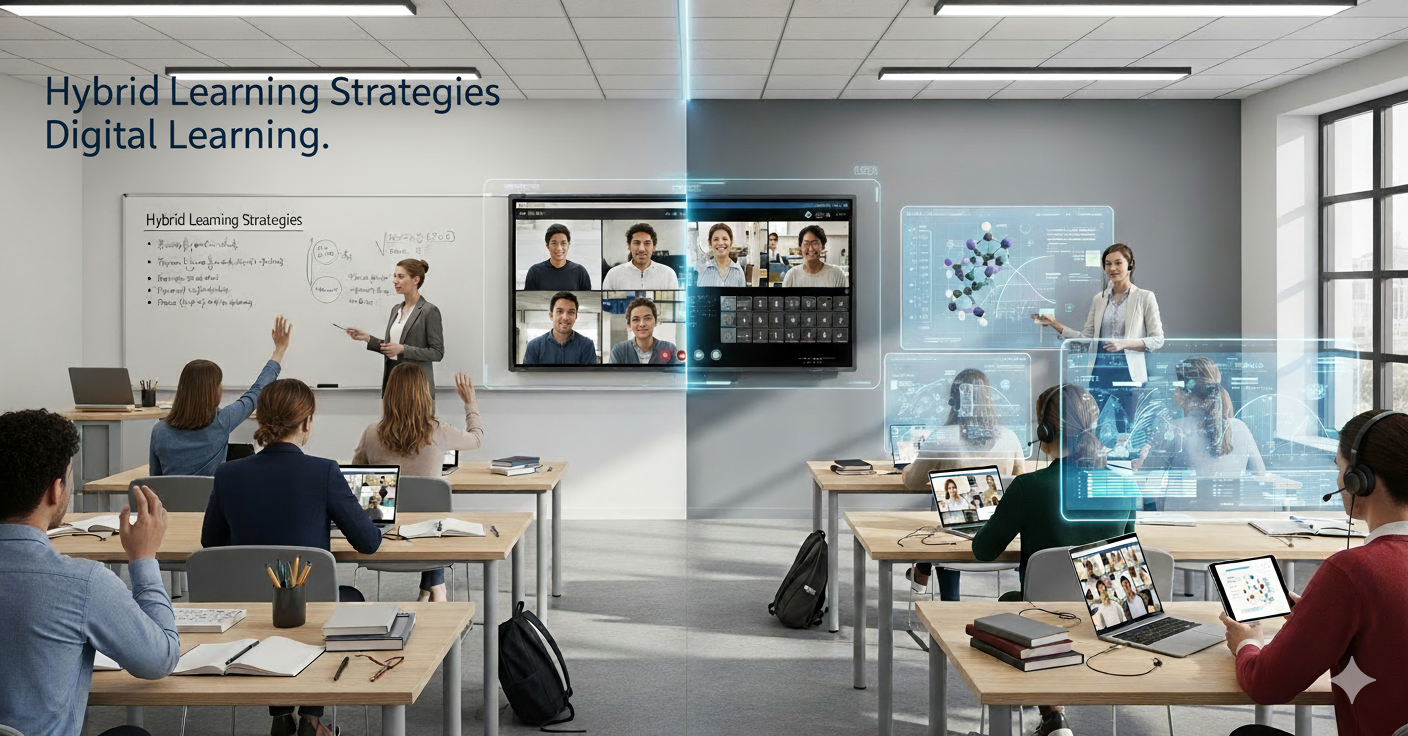
Introduction Education has always evolved with society. From chalkboards to digital whiteboards, from traditional classrooms to virtual learning spaces, each transformation has reflected the needs and challenges of its time. In recent years, the global shift toward online education, accelerated by the pandemic, has changed the way we think about learning. Yet, as valuable as online platforms are, they cannot fully replace the benefits of in-person interaction. This is where hybrid learning steps in—a model that blends the flexibility of online education with the collaborative and human-centered nature of classroom teaching. Hybrid learning is no longer just an emergency response or a temporary experiment. It is becoming a permanent, future-ready approach to education. This blog explores what hybrid learning means, why it has risen to prominence, its benefits and challenges, and how it is shaping the future of teaching and learning.
Hybrid learning, also known as blended learning, is an approach that combines both face-to-face classroom instruction and online digital learning experiences. It allows students to switch seamlessly between physical and virtual environments, enabling them to benefit from the strengths of both.
Unlike traditional classroom learning, where all students receive the same instruction at the same pace, or fully online learning, which often lacks interpersonal interaction, hybrid learning strikes a balance. It provides structure and flexibility, guidance and independence, interaction and personalization.
Key Point: Hybrid learning is not a replacement for either online or traditional education—it is an integration of both to create a richer, more adaptable model of learning.
Several factors explain why hybrid learning has become one of the most discussed trends in education today.
Hybrid learning makes education more inclusive. Students can attend sessions physically when possible but also participate remotely if they face health, geographical, or scheduling challenges. This flexibility ensures that learning continues without interruption.
Digital tools used in hybrid education adapt to the pace and learning style of individual students. Online platforms can provide quizzes, videos, and extra resources, while in-person teaching reinforces concepts through collaboration and discussion.
The COVID-19 pandemic highlighted the vulnerabilities of traditional education systems. Hybrid learning emerged as a sustainable solution that can continue even during global disruptions, ensuring continuity of education.
Point to Be Noted: Hybrid learning is not just a short-term fix. It is a long-term model that prepares educational systems for a more uncertain but technology-driven future
.
Hybrid classrooms combine the interactivity of digital tools with the energy of in-person discussions. Online platforms introduce gamification, multimedia resources, and interactive assignments, while classroom time is dedicated to deeper exploration of ideas and peer-to-peer collaboration.
In hybrid environments, students can work on projects using virtual tools and also engage in real-world teamwork when they meet in person. This builds not only academic knowledge but also important life skills such as communication and collaboration.
Hybrid learning makes teaching more efficient. Teachers can use online platforms to monitor student progress, assess performance, and provide feedback. Automated grading and data-driven insights free up time that teachers can dedicate to mentoring and facilitating critical thinking.
Do You Know Why? Because hybrid learning transforms classrooms from passive lecture-based environments into active, student-centered spaces where learning happens through engagement, inquiry, and collaboration.
Like any innovation, hybrid learning comes with challenges that need to be addressed for it to reach its full potential.
The Digital Divide: Not all students have equal access to high-speed internet, reliable devices, or digital literacy skills. This gap can create inequalities in learning outcomes.
Teacher Preparedness: Many educators require training and support to effectively integrate digital tools with classroom teaching. Without this, hybrid classrooms risk becoming fragmented.
Student Accountability: Hybrid learning demands self-discipline. Some students may struggle with the independence required in the online component, leading to disengagement.
Point to Be Noted: For hybrid learning to succeed, educational institutions and policymakers must invest in infrastructure, teacher training, and strategies to bridge the digital divide.
Hybrid learning can take many forms, depending on the institution, subject, and learners involved.
Flipped Classrooms: Students learn basic concepts at home through videos and readings, then use classroom time for discussions, problem-solving, and applying knowledge.
Live Streaming and Recording: Lectures are streamed for students who cannot attend in person, while recordings allow for flexible review.
AI-Powered Platforms: Artificial intelligence tools suggest resources, provide personalized assessments, and support teachers in adapting lessons to individual needs.
Key Point: Hybrid learning is adaptable. It can be customized for different age groups, disciplines, and learning objectives, making it a versatile model for education.
Hybrid learning is not a passing trend—it is a foundational shift. As technology advances, the hybrid model will continue to evolve. Some future possibilities include:
Immersive Learning with Virtual and Augmented Reality: Students may soon experience history by walking through virtual recreations of ancient cities or explore science through 3D simulations.
AI-Driven Personalized Education: Intelligent platforms will provide real-time feedback, adapting learning materials instantly to the needs of each student.
Global Classrooms: Hybrid learning opens opportunities for international collaboration, allowing students from different countries to connect, share ideas, and learn together.
Do You Know Why This Matters? Because hybrid learning is not limited by borders. It has the potential to make education global, inclusive, and future-ready.
The rise of hybrid learning signals a new era in education. By blending the best aspects of online flexibility and in-person engagement, it offers a model that is more resilient, adaptable, and effective than traditional approaches alone.
Point to Be Noted: Hybrid learning is not a compromise between two systems—it is an enhancement that unlocks the strengths of both.
As schools and universities continue to embrace hybrid models, education is becoming more personalized, inclusive, and prepared for the challenges of tomorrow. The classroom of the future is already here, and it is hybrid.